Case Study On Crohn’s disease
VerifiedAdded on 2022/08/18
|6
|1559
|12
AI Summary
Contribute Materials
Your contribution can guide someone’s learning journey. Share your
documents today.
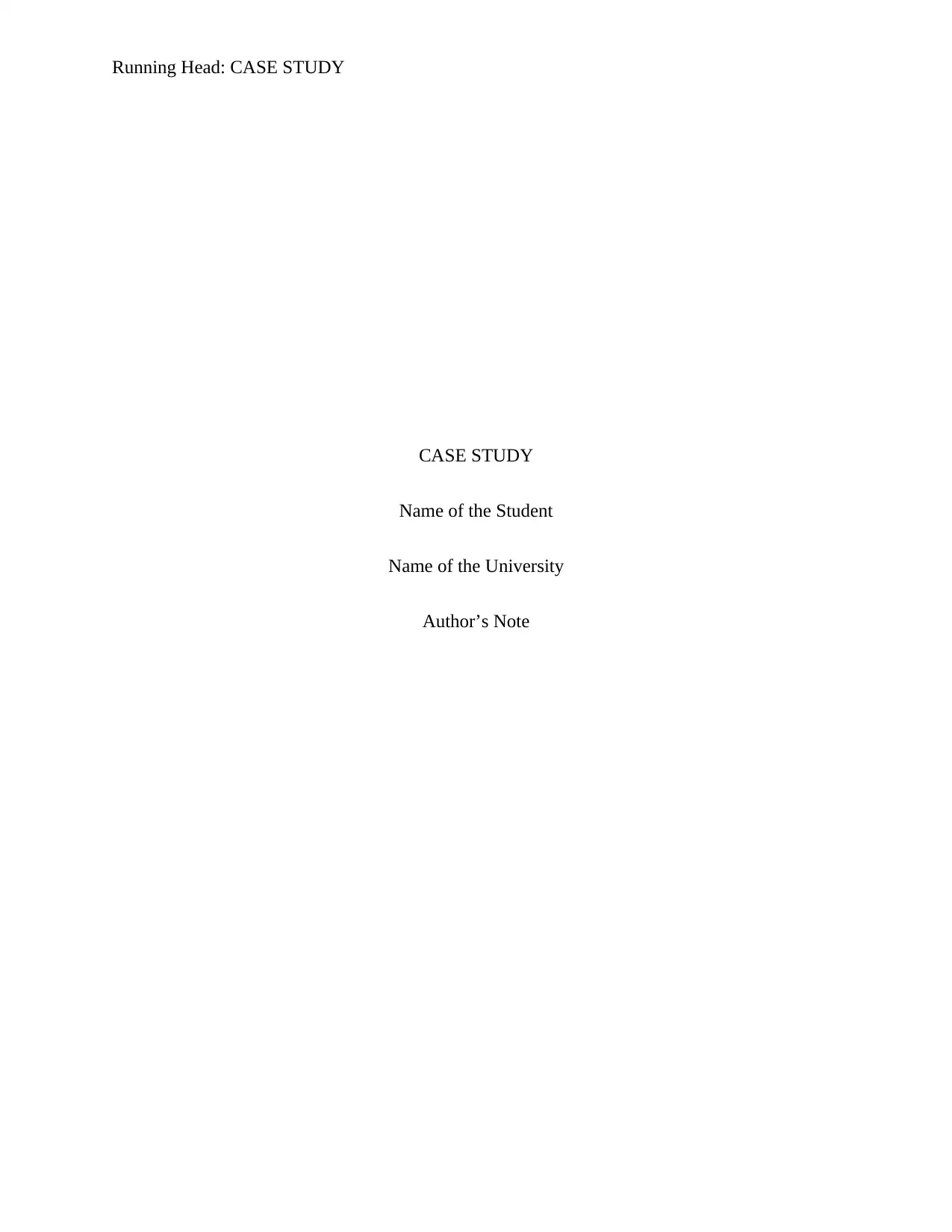
Running Head: CASE STUDY
CASE STUDY
Name of the Student
Name of the University
Author’s Note
CASE STUDY
Name of the Student
Name of the University
Author’s Note
Secure Best Marks with AI Grader
Need help grading? Try our AI Grader for instant feedback on your assignments.
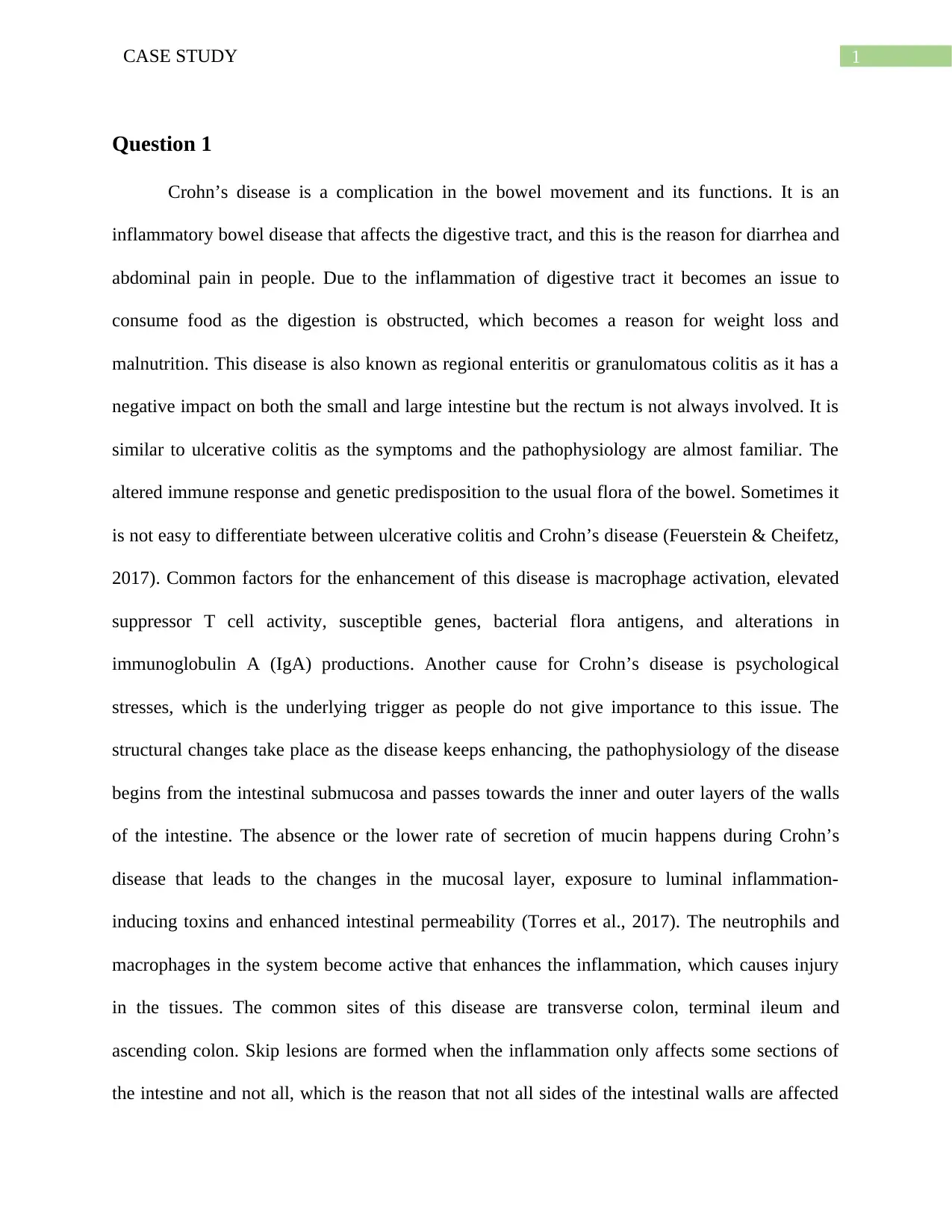
1CASE STUDY
Question 1
Crohn’s disease is a complication in the bowel movement and its functions. It is an
inflammatory bowel disease that affects the digestive tract, and this is the reason for diarrhea and
abdominal pain in people. Due to the inflammation of digestive tract it becomes an issue to
consume food as the digestion is obstructed, which becomes a reason for weight loss and
malnutrition. This disease is also known as regional enteritis or granulomatous colitis as it has a
negative impact on both the small and large intestine but the rectum is not always involved. It is
similar to ulcerative colitis as the symptoms and the pathophysiology are almost familiar. The
altered immune response and genetic predisposition to the usual flora of the bowel. Sometimes it
is not easy to differentiate between ulcerative colitis and Crohn’s disease (Feuerstein & Cheifetz,
2017). Common factors for the enhancement of this disease is macrophage activation, elevated
suppressor T cell activity, susceptible genes, bacterial flora antigens, and alterations in
immunoglobulin A (IgA) productions. Another cause for Crohn’s disease is psychological
stresses, which is the underlying trigger as people do not give importance to this issue. The
structural changes take place as the disease keeps enhancing, the pathophysiology of the disease
begins from the intestinal submucosa and passes towards the inner and outer layers of the walls
of the intestine. The absence or the lower rate of secretion of mucin happens during Crohn’s
disease that leads to the changes in the mucosal layer, exposure to luminal inflammation-
inducing toxins and enhanced intestinal permeability (Torres et al., 2017). The neutrophils and
macrophages in the system become active that enhances the inflammation, which causes injury
in the tissues. The common sites of this disease are transverse colon, terminal ileum and
ascending colon. Skip lesions are formed when the inflammation only affects some sections of
the intestine and not all, which is the reason that not all sides of the intestinal walls are affected
Question 1
Crohn’s disease is a complication in the bowel movement and its functions. It is an
inflammatory bowel disease that affects the digestive tract, and this is the reason for diarrhea and
abdominal pain in people. Due to the inflammation of digestive tract it becomes an issue to
consume food as the digestion is obstructed, which becomes a reason for weight loss and
malnutrition. This disease is also known as regional enteritis or granulomatous colitis as it has a
negative impact on both the small and large intestine but the rectum is not always involved. It is
similar to ulcerative colitis as the symptoms and the pathophysiology are almost familiar. The
altered immune response and genetic predisposition to the usual flora of the bowel. Sometimes it
is not easy to differentiate between ulcerative colitis and Crohn’s disease (Feuerstein & Cheifetz,
2017). Common factors for the enhancement of this disease is macrophage activation, elevated
suppressor T cell activity, susceptible genes, bacterial flora antigens, and alterations in
immunoglobulin A (IgA) productions. Another cause for Crohn’s disease is psychological
stresses, which is the underlying trigger as people do not give importance to this issue. The
structural changes take place as the disease keeps enhancing, the pathophysiology of the disease
begins from the intestinal submucosa and passes towards the inner and outer layers of the walls
of the intestine. The absence or the lower rate of secretion of mucin happens during Crohn’s
disease that leads to the changes in the mucosal layer, exposure to luminal inflammation-
inducing toxins and enhanced intestinal permeability (Torres et al., 2017). The neutrophils and
macrophages in the system become active that enhances the inflammation, which causes injury
in the tissues. The common sites of this disease are transverse colon, terminal ileum and
ascending colon. Skip lesions are formed when the inflammation only affects some sections of
the intestine and not all, which is the reason that not all sides of the intestinal walls are affected
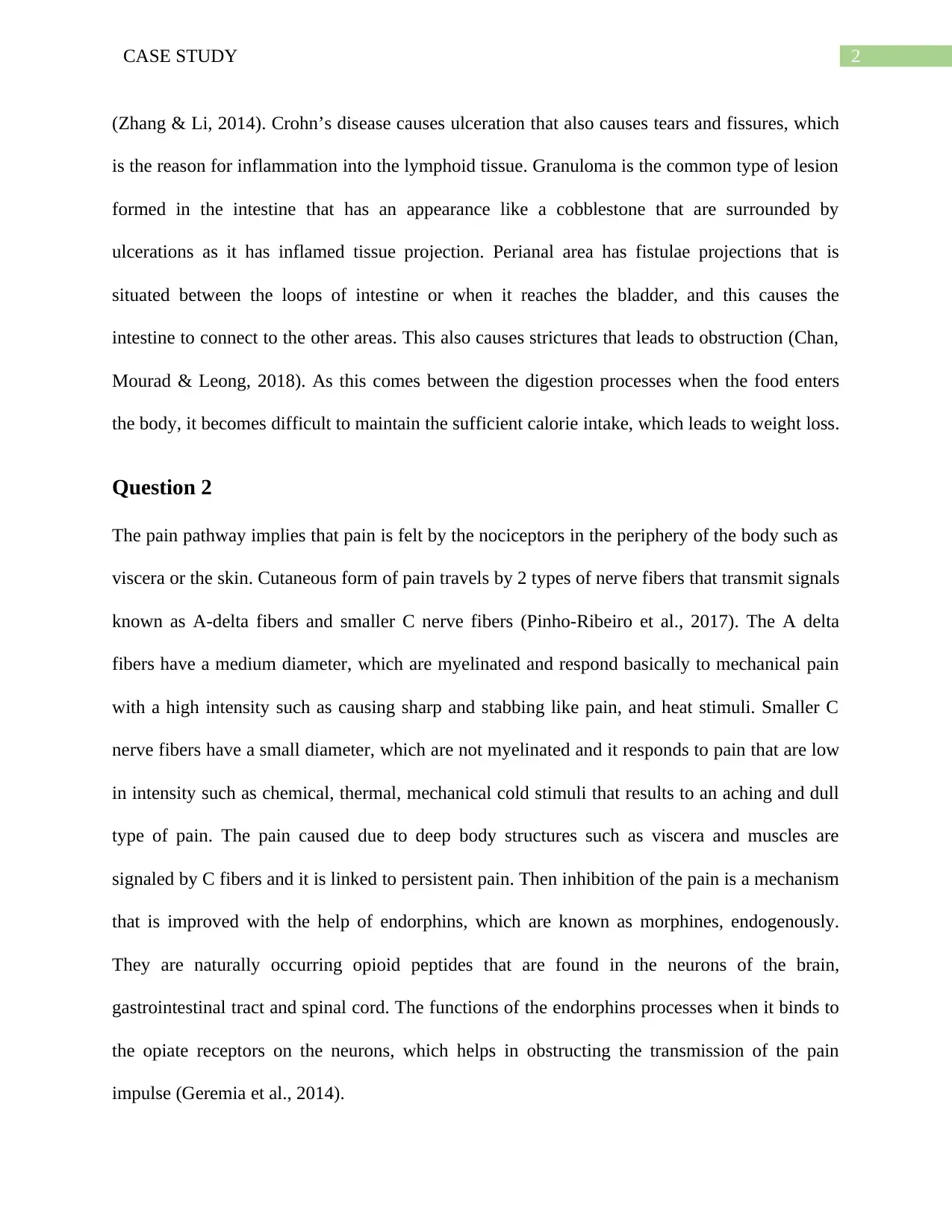
2CASE STUDY
(Zhang & Li, 2014). Crohn’s disease causes ulceration that also causes tears and fissures, which
is the reason for inflammation into the lymphoid tissue. Granuloma is the common type of lesion
formed in the intestine that has an appearance like a cobblestone that are surrounded by
ulcerations as it has inflamed tissue projection. Perianal area has fistulae projections that is
situated between the loops of intestine or when it reaches the bladder, and this causes the
intestine to connect to the other areas. This also causes strictures that leads to obstruction (Chan,
Mourad & Leong, 2018). As this comes between the digestion processes when the food enters
the body, it becomes difficult to maintain the sufficient calorie intake, which leads to weight loss.
Question 2
The pain pathway implies that pain is felt by the nociceptors in the periphery of the body such as
viscera or the skin. Cutaneous form of pain travels by 2 types of nerve fibers that transmit signals
known as A-delta fibers and smaller C nerve fibers (Pinho-Ribeiro et al., 2017). The A delta
fibers have a medium diameter, which are myelinated and respond basically to mechanical pain
with a high intensity such as causing sharp and stabbing like pain, and heat stimuli. Smaller C
nerve fibers have a small diameter, which are not myelinated and it responds to pain that are low
in intensity such as chemical, thermal, mechanical cold stimuli that results to an aching and dull
type of pain. The pain caused due to deep body structures such as viscera and muscles are
signaled by C fibers and it is linked to persistent pain. Then inhibition of the pain is a mechanism
that is improved with the help of endorphins, which are known as morphines, endogenously.
They are naturally occurring opioid peptides that are found in the neurons of the brain,
gastrointestinal tract and spinal cord. The functions of the endorphins processes when it binds to
the opiate receptors on the neurons, which helps in obstructing the transmission of the pain
impulse (Geremia et al., 2014).
(Zhang & Li, 2014). Crohn’s disease causes ulceration that also causes tears and fissures, which
is the reason for inflammation into the lymphoid tissue. Granuloma is the common type of lesion
formed in the intestine that has an appearance like a cobblestone that are surrounded by
ulcerations as it has inflamed tissue projection. Perianal area has fistulae projections that is
situated between the loops of intestine or when it reaches the bladder, and this causes the
intestine to connect to the other areas. This also causes strictures that leads to obstruction (Chan,
Mourad & Leong, 2018). As this comes between the digestion processes when the food enters
the body, it becomes difficult to maintain the sufficient calorie intake, which leads to weight loss.
Question 2
The pain pathway implies that pain is felt by the nociceptors in the periphery of the body such as
viscera or the skin. Cutaneous form of pain travels by 2 types of nerve fibers that transmit signals
known as A-delta fibers and smaller C nerve fibers (Pinho-Ribeiro et al., 2017). The A delta
fibers have a medium diameter, which are myelinated and respond basically to mechanical pain
with a high intensity such as causing sharp and stabbing like pain, and heat stimuli. Smaller C
nerve fibers have a small diameter, which are not myelinated and it responds to pain that are low
in intensity such as chemical, thermal, mechanical cold stimuli that results to an aching and dull
type of pain. The pain caused due to deep body structures such as viscera and muscles are
signaled by C fibers and it is linked to persistent pain. Then inhibition of the pain is a mechanism
that is improved with the help of endorphins, which are known as morphines, endogenously.
They are naturally occurring opioid peptides that are found in the neurons of the brain,
gastrointestinal tract and spinal cord. The functions of the endorphins processes when it binds to
the opiate receptors on the neurons, which helps in obstructing the transmission of the pain
impulse (Geremia et al., 2014).
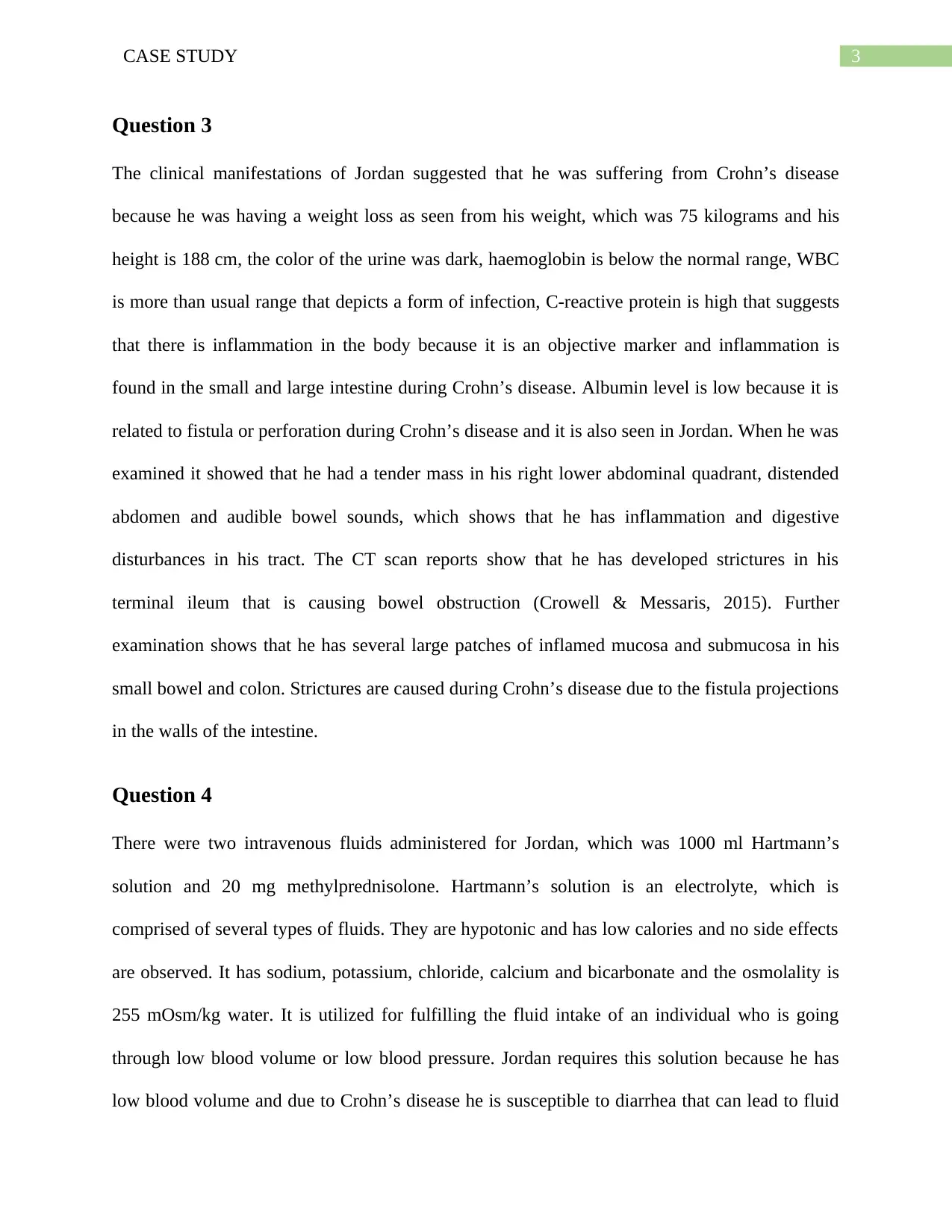
3CASE STUDY
Question 3
The clinical manifestations of Jordan suggested that he was suffering from Crohn’s disease
because he was having a weight loss as seen from his weight, which was 75 kilograms and his
height is 188 cm, the color of the urine was dark, haemoglobin is below the normal range, WBC
is more than usual range that depicts a form of infection, C-reactive protein is high that suggests
that there is inflammation in the body because it is an objective marker and inflammation is
found in the small and large intestine during Crohn’s disease. Albumin level is low because it is
related to fistula or perforation during Crohn’s disease and it is also seen in Jordan. When he was
examined it showed that he had a tender mass in his right lower abdominal quadrant, distended
abdomen and audible bowel sounds, which shows that he has inflammation and digestive
disturbances in his tract. The CT scan reports show that he has developed strictures in his
terminal ileum that is causing bowel obstruction (Crowell & Messaris, 2015). Further
examination shows that he has several large patches of inflamed mucosa and submucosa in his
small bowel and colon. Strictures are caused during Crohn’s disease due to the fistula projections
in the walls of the intestine.
Question 4
There were two intravenous fluids administered for Jordan, which was 1000 ml Hartmann’s
solution and 20 mg methylprednisolone. Hartmann’s solution is an electrolyte, which is
comprised of several types of fluids. They are hypotonic and has low calories and no side effects
are observed. It has sodium, potassium, chloride, calcium and bicarbonate and the osmolality is
255 mOsm/kg water. It is utilized for fulfilling the fluid intake of an individual who is going
through low blood volume or low blood pressure. Jordan requires this solution because he has
low blood volume and due to Crohn’s disease he is susceptible to diarrhea that can lead to fluid
Question 3
The clinical manifestations of Jordan suggested that he was suffering from Crohn’s disease
because he was having a weight loss as seen from his weight, which was 75 kilograms and his
height is 188 cm, the color of the urine was dark, haemoglobin is below the normal range, WBC
is more than usual range that depicts a form of infection, C-reactive protein is high that suggests
that there is inflammation in the body because it is an objective marker and inflammation is
found in the small and large intestine during Crohn’s disease. Albumin level is low because it is
related to fistula or perforation during Crohn’s disease and it is also seen in Jordan. When he was
examined it showed that he had a tender mass in his right lower abdominal quadrant, distended
abdomen and audible bowel sounds, which shows that he has inflammation and digestive
disturbances in his tract. The CT scan reports show that he has developed strictures in his
terminal ileum that is causing bowel obstruction (Crowell & Messaris, 2015). Further
examination shows that he has several large patches of inflamed mucosa and submucosa in his
small bowel and colon. Strictures are caused during Crohn’s disease due to the fistula projections
in the walls of the intestine.
Question 4
There were two intravenous fluids administered for Jordan, which was 1000 ml Hartmann’s
solution and 20 mg methylprednisolone. Hartmann’s solution is an electrolyte, which is
comprised of several types of fluids. They are hypotonic and has low calories and no side effects
are observed. It has sodium, potassium, chloride, calcium and bicarbonate and the osmolality is
255 mOsm/kg water. It is utilized for fulfilling the fluid intake of an individual who is going
through low blood volume or low blood pressure. Jordan requires this solution because he has
low blood volume and due to Crohn’s disease he is susceptible to diarrhea that can lead to fluid
Secure Best Marks with AI Grader
Need help grading? Try our AI Grader for instant feedback on your assignments.

4CASE STUDY
loss. Hartmann’s solution has been beneficial for people with Crohn’s disease as it helps in
maintaining the fluid balance. It is necessary to monitor his fluid balance because in extreme
cases of Crohn’s disease an individual can suffer from diarrhea, which is a common
complication in this disease (Forbes, 2014). The fluid balance in Jordan requires intervention and
proper medical treatment but due to his obstruction in eating and digestion, it is recommended to
administer him with intravenous fluids such as Hartmann’s solution. As it is an electrolyte it will
help in decreasing his issues.
loss. Hartmann’s solution has been beneficial for people with Crohn’s disease as it helps in
maintaining the fluid balance. It is necessary to monitor his fluid balance because in extreme
cases of Crohn’s disease an individual can suffer from diarrhea, which is a common
complication in this disease (Forbes, 2014). The fluid balance in Jordan requires intervention and
proper medical treatment but due to his obstruction in eating and digestion, it is recommended to
administer him with intravenous fluids such as Hartmann’s solution. As it is an electrolyte it will
help in decreasing his issues.
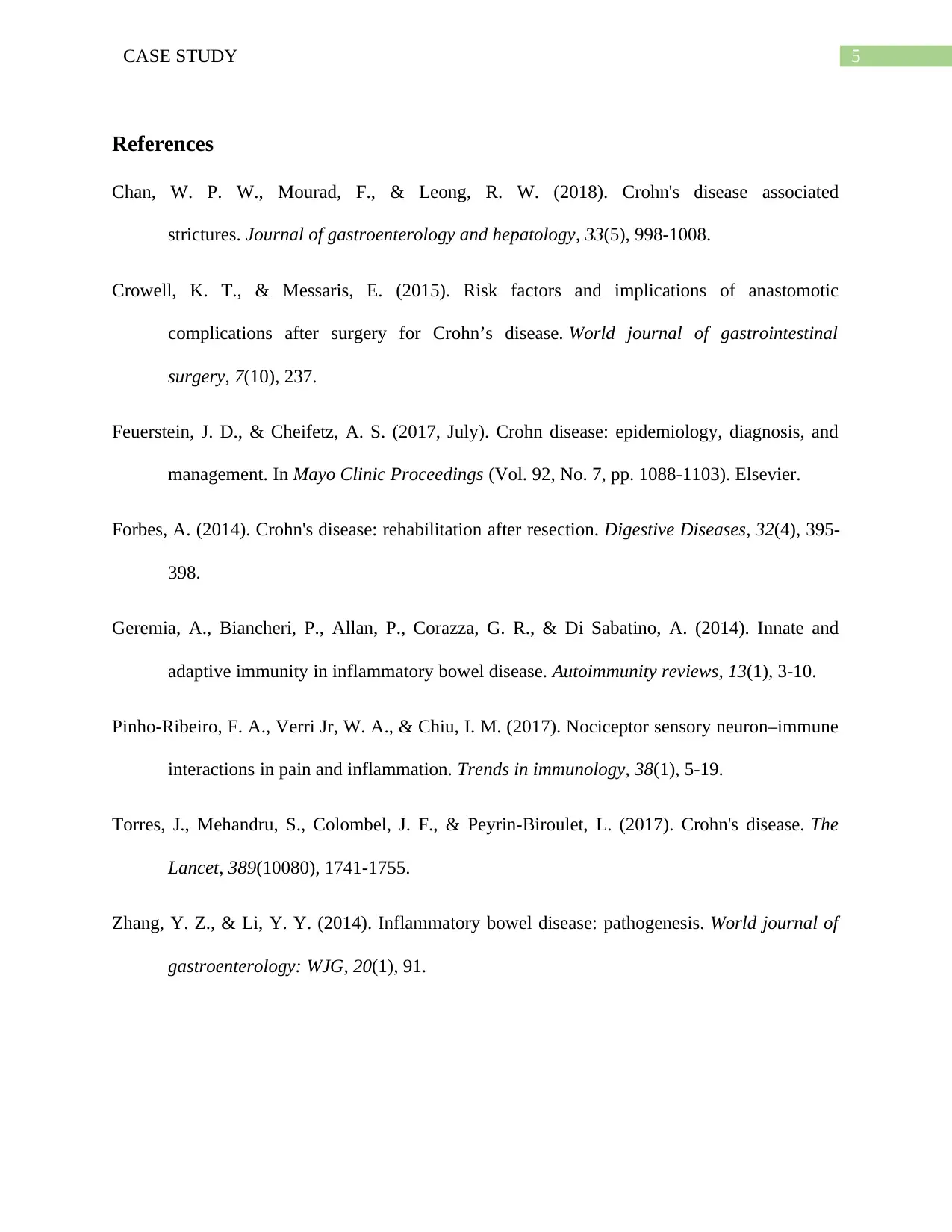
5CASE STUDY
References
Chan, W. P. W., Mourad, F., & Leong, R. W. (2018). Crohn's disease associated
strictures. Journal of gastroenterology and hepatology, 33(5), 998-1008.
Crowell, K. T., & Messaris, E. (2015). Risk factors and implications of anastomotic
complications after surgery for Crohn’s disease. World journal of gastrointestinal
surgery, 7(10), 237.
Feuerstein, J. D., & Cheifetz, A. S. (2017, July). Crohn disease: epidemiology, diagnosis, and
management. In Mayo Clinic Proceedings (Vol. 92, No. 7, pp. 1088-1103). Elsevier.
Forbes, A. (2014). Crohn's disease: rehabilitation after resection. Digestive Diseases, 32(4), 395-
398.
Geremia, A., Biancheri, P., Allan, P., Corazza, G. R., & Di Sabatino, A. (2014). Innate and
adaptive immunity in inflammatory bowel disease. Autoimmunity reviews, 13(1), 3-10.
Pinho-Ribeiro, F. A., Verri Jr, W. A., & Chiu, I. M. (2017). Nociceptor sensory neuron–immune
interactions in pain and inflammation. Trends in immunology, 38(1), 5-19.
Torres, J., Mehandru, S., Colombel, J. F., & Peyrin-Biroulet, L. (2017). Crohn's disease. The
Lancet, 389(10080), 1741-1755.
Zhang, Y. Z., & Li, Y. Y. (2014). Inflammatory bowel disease: pathogenesis. World journal of
gastroenterology: WJG, 20(1), 91.
References
Chan, W. P. W., Mourad, F., & Leong, R. W. (2018). Crohn's disease associated
strictures. Journal of gastroenterology and hepatology, 33(5), 998-1008.
Crowell, K. T., & Messaris, E. (2015). Risk factors and implications of anastomotic
complications after surgery for Crohn’s disease. World journal of gastrointestinal
surgery, 7(10), 237.
Feuerstein, J. D., & Cheifetz, A. S. (2017, July). Crohn disease: epidemiology, diagnosis, and
management. In Mayo Clinic Proceedings (Vol. 92, No. 7, pp. 1088-1103). Elsevier.
Forbes, A. (2014). Crohn's disease: rehabilitation after resection. Digestive Diseases, 32(4), 395-
398.
Geremia, A., Biancheri, P., Allan, P., Corazza, G. R., & Di Sabatino, A. (2014). Innate and
adaptive immunity in inflammatory bowel disease. Autoimmunity reviews, 13(1), 3-10.
Pinho-Ribeiro, F. A., Verri Jr, W. A., & Chiu, I. M. (2017). Nociceptor sensory neuron–immune
interactions in pain and inflammation. Trends in immunology, 38(1), 5-19.
Torres, J., Mehandru, S., Colombel, J. F., & Peyrin-Biroulet, L. (2017). Crohn's disease. The
Lancet, 389(10080), 1741-1755.
Zhang, Y. Z., & Li, Y. Y. (2014). Inflammatory bowel disease: pathogenesis. World journal of
gastroenterology: WJG, 20(1), 91.
1 out of 6
Related Documents
Your All-in-One AI-Powered Toolkit for Academic Success.
+13062052269
info@desklib.com
Available 24*7 on WhatsApp / Email
![[object Object]](/_next/static/media/star-bottom.7253800d.svg)
Unlock your academic potential
© 2024 | Zucol Services PVT LTD | All rights reserved.





